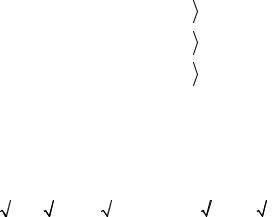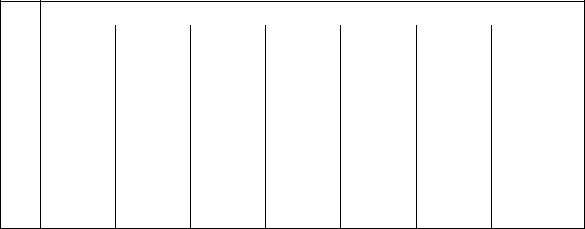
Yuriy Kruglyak. Quantum Chemistry_Kiev_1963-1991
.pdf
|
|
|
|
|
|
|
|
A+ |
A+ |
A+ |
|
|
0 |
|
|
|
|
|
||
|
|
|
|
|
|
|
|
|
|
|||||||||||
|
|
|
|
|
|
|
|
|
kα |
lα |
mβ |
|
|
|
|
|
|
|
|
|
A+ |
A+ |
A+ |
A+ |
× A+ |
A+ |
A+ |
|
|
0 . |
|
|
|
|
(263) |
||||||
|
||||||||||||||||||||
iα |
|
iβ |
jα |
|
|
jβ |
|
kα lβ |
mα |
|
|
|
|
|
|
|
|
|||
|
|
|
|
|
|
|
|
+ |
|
+ |
+ |
|
|
0 |
|
|
|
|
|
|
|
|
|
|
|
|
|
|
|
|
|
|
|
|
|
||||||
|
|
|
|
|
|
|
|
A |
A A |
|
|
|
|
|
|
|
||||
|
|
|
|
|
|
|
|
|
kβ |
lα |
mα |
|
|
|
|
|
|
|
|
|
|
|
|
|
|
|
|
|
|
|
|
|
|
|
|
|
|||||
A linear combination of these configurations is written symbolically as |
|
|||||||||||||||||||
C1ααβ +C2αβα +C3βαα . |
(264) |
|||||||||||||||||||
Two sets of coefficients (1/ |
|
|
|
|
|
|
|
|
and |
(1/ |
|
|
|
|
give the two |
|||||
6, 1 / |
6, − 2 / |
6) |
2, −1/ 2, 0) |
|||||||||||||||||
orthonormal doublet basis vectors.
For configurations with five and seven unpaired electrons the number of different spin-configurations with MS = +1 / 2 is equal to 10 and 35, and the number of
possible mutually orthogonal basis vectors is equal to 5 and 14. The corresponding sets of coefficients in the linear combination of type (264) obtained by the VB method [24] with subsequent orthogonalization are collected in Table 8. For convenience of listing these vectors are not normalized.
Expansion coefficients of all 35 basis vectors with seven unpaired electrons over spin-configurations can be found in Table 9 [22].
Table 8 Expansion coefficients of the basis vectors
with five unpaired electrons over spin-configurations
Spin- |
|
Basis vectors |
|
||
configuration |
|
|
|||
|
|
|
|
|
|
|
|
|
|
|
|
αααββ |
0 |
0 |
–1 |
–1 |
1 |
ααβαβ |
0 |
0 |
1 |
1 |
1 |
αβααβ |
2 |
0 |
0 |
0 |
–1 |
βαααβ |
–2 |
0 |
0 |
0 |
–1 |
ααββα |
0 |
0 |
–1 |
1 |
–1 |
αβαβα |
–1 |
1 |
1 |
0 |
0 |
βααβα |
1 |
–1 |
1 |
0 |
0 |
αββαα |
–1 |
–1 |
0 |
–1 |
0 |
βαβαα |
1 |
1 |
0 |
–1 |
0 |
ββααα |
0 |
0 |
–1 |
1 |
1 |
The number of possible doublet basis vectors corresponding to different types of configurations is indicated in parenthesis in Table 7. The total number of basis vectors related to singly excited configurations of symmetry 2B2 is equal to 14,
130
doubly – to 74, triply – to 150, quadruply – to 122, quintuply – to 38, and sextuply – to 5.
Computations were performed with seven sets of basis vectors – G, I, II, III, IV, V, and F. Set G represents only the ground state configuration of benzyl. Each of the other sets was extended compared with previous one at the expense of the basis vectors corresponding to configurations of the next higher order of excitation. Thus the size of the configurational sets used was equal to 1, 15, 89, 239, 361, and 404 correspondingly. Set F with 404 configurations corresponds to the wave function with full CI.
In order to perform CI computations one usually finds analytical expressions for matrix elements of the Hamiltonian over the basis vectors of different types. In our case this traditional way is not acceptable for most of the expressions to be programmed are cumbersome and the number of them is too large.
We rejected a derivation of the analytical expressions for the Hamiltonian matrix elements and entrusted this job to a computer at an early stage. To do this it was necessary to program simple rules for calculation of the matrix elements in the second quantization representation which follow from Wick’s theorems and are equally good for configurations of arbitrary complexity. Necessary rules are given in
# 5 above.
Table 9 Expansion coefficients of the basis vectors with seven unpaired electrons
over spin-configurations
Spin-conf |
|
|
|
|
|
Basis vectors |
|
|
|
|
|
|
|||
ααααβββ |
–4 |
4 |
0 |
0 |
0 |
0 |
0 |
0 |
|
0 |
0 |
0 |
0 |
0 |
0 |
αααβαββ |
1 |
–1 |
1 |
1 |
1 |
0 |
0 |
0 |
|
0 |
1 |
1 |
0 |
0 |
0 |
ααβααββ |
1 |
–1 |
1 |
–1 |
–1 |
0 |
0 |
0 |
|
0 |
1 |
–1 |
0 |
0 |
0 |
αβαααββ |
1 |
–1 |
–1 |
1 |
–1 |
0 |
0 |
0 |
|
0 |
–1 |
0 |
1 |
0 |
0 |
βααααββ |
1 |
–1 |
–1 |
–1 |
1 |
0 |
0 |
0 |
|
0 |
–1 |
0 |
–1 |
0 |
0 |
αααββαβ |
1 |
–1 |
1 |
–1 |
–1 |
0 |
0 |
0 |
|
0 |
–1 |
1 |
0 |
0 |
0 |
ααβαβαβ |
1 |
–1 |
1 |
1 |
1 |
0 |
0 |
0 |
|
0 |
–1 |
–1 |
0 |
0 |
0 |
αβααβαβ |
1 |
–1 |
–1 |
–1 |
1 |
0 |
0 |
0 |
|
0 |
1 |
0 |
1 |
0 |
0 |
βαααβαβ |
1 |
–1 |
–1 |
1 |
–1 |
0 |
0 |
0 |
|
0 |
1 |
0 |
–1 |
0 |
0 |
ααββααβ |
6 |
2 |
–2 |
0 |
0 |
0 |
0 |
0 |
|
0 |
0 |
0 |
0 |
0 |
0 |
αβαβααβ |
–4 |
0 |
0 |
0 |
0 |
1 |
1 |
0 |
|
0 |
0 |
–1 |
–1 |
0 |
0 |
βααβααβ |
–4 |
0 |
0 |
0 |
0 |
–1 |
–1 |
0 |
|
0 |
0 |
–1 |
1 |
0 |
0 |
αββαααβ |
–4 |
0 |
0 |
0 |
0 |
–1 |
–1 |
0 |
|
0 |
0 |
1 |
–1 |
0 |
0 |
βαβαααβ |
–4 |
0 |
0 |
0 |
0 |
1 |
1 |
0 |
|
0 |
0 |
1 |
1 |
0 |
0 |
ββααααβ |
6 |
2 |
2 |
0 |
0 |
0 |
0 |
0 |
|
0 |
0 |
0 |
0 |
0 |
0 |
131

αααβββα |
1 |
–1 |
–1 |
0 |
0 |
1 |
–1 |
0 |
0 |
0 |
–1 |
0 |
1 |
0 |
ααβαββα |
1 |
–1 |
–1 |
0 |
0 |
–1 |
1 |
0 |
0 |
0 |
1 |
0 |
1 |
0 |
αβααββα |
1 |
–1 |
1 |
0 |
0 |
0 |
0 |
1 |
1 |
0 |
0 |
–1 |
–1 |
0 |
βαααββα |
1 |
–1 |
1 |
0 |
0 |
0 |
0 |
–1 |
–1 |
0 |
0 |
1 |
–1 |
0 |
ααββαβα |
–4 |
0 |
0 |
0 |
0 |
0 |
0 |
1 |
–1 |
–1 |
0 |
0 |
–1 |
0 |
αβαβαβα |
1 |
1 |
0 |
–1 |
0 |
–1 |
0 |
–1 |
0 |
0 |
0 |
0 |
0 |
1 |
βααβαβα |
1 |
1 |
0 |
0 |
–1 |
0 |
1 |
0 |
1 |
0 |
0 |
0 |
0 |
–1 |
αββααβα |
1 |
1 |
0 |
0 |
1 |
1 |
0 |
–1 |
0 |
0 |
0 |
0 |
0 |
–1 |
βαβααβα |
1 |
1 |
0 |
1 |
0 |
0 |
–1 |
0 |
1 |
0 |
0 |
0 |
0 |
1 |
ββαααβα |
–4 |
0 |
0 |
0 |
0 |
0 |
0 |
1 |
–1 |
1 |
0 |
0 |
1 |
0 |
ααβββαα |
–4 |
0 |
0 |
0 |
0 |
0 |
0 |
–1 |
1 |
1 |
0 |
0 |
–1 |
0 |
αβαββαα |
1 |
1 |
0 |
1 |
0 |
–1 |
0 |
0 |
–1 |
0 |
0 |
0 |
0 |
–1 |
βααββαα |
1 |
1 |
0 |
0 |
1 |
0 |
1 |
1 |
0 |
0 |
0 |
0 |
0 |
1 |
αββαβαα |
1 |
1 |
0 |
0 |
–1 |
1 |
0 |
0 |
–1 |
0 |
0 |
0 |
0 |
1 |
βαβαβαα |
1 |
1 |
0 |
–1 |
0 |
0 |
–1 |
1 |
0 |
0 |
0 |
0 |
0 |
–1 |
ββααβαα |
–4 |
0 |
0 |
0 |
0 |
0 |
0 |
–1 |
1 |
–1 |
0 |
0 |
1 |
0 |
αβββααα |
1 |
–1 |
1 |
0 |
0 |
0 |
0 |
1 |
1 |
0 |
0 |
1 |
1 |
0 |
βαββααα |
1 |
–1 |
1 |
0 |
0 |
0 |
0 |
–1 |
–1 |
0 |
0 |
–1 |
1 |
0 |
ββαβααα |
1 |
–1 |
–1 |
0 |
0 |
1 |
–1 |
0 |
0 |
0 |
1 |
0 |
–1 |
0 |
βββαααα |
1 |
–1 |
–1 |
0 |
0 |
–1 |
1 |
0 |
0 |
0 |
–1 |
0 |
–1 |
0 |
Occupation numbers of one-particle states for electrons are equal to 0 or 1. Therefore the computer code is ideally suitable to record vectors of type (262). The first eigenvalues and corresponding eigenvectors of the CI matrix were computed by an algorithm proposed by Nesbet [25]. As an initial approximation for the diagonalization of the next matrix we used the eigenvector of the previous matrix of lower order.
2.7.3.7.2. Discussion of Results
The energy of the ground state of the benzyl radical computed with different configurational sets is given in Table 10. The difference between the energy corresponding to full CI and the energy obtained in the single-configuration approximation will be called the correlation energy for a given model Hamiltonian. It is seen from Table 10 that the correlation energy in our case is equal to –0.929722 eV. With the singly excited configurations only 18% of this energy is taken into account. Extension of the basis to include doubly excited configurations leads to an account of almost all the correlation energy, namely 94%. Analogous changes occur with the overlap integral S =  ΨF Ψtri
ΨF Ψtri  which may be taken as a measure of the
which may be taken as a measure of the
132

accuracy of the trial wave function. The deviation from unity of the projection of the approximate wave function on the exact one is 0.0547 for the single-configuration function and is 0.0334 when all singly excited configurations are included. When all doubly excited configurations are included this deviation decreases sharply to 0.0020 which indicative of the marked improvement of the wave function.
Table 10
Change in energy E of the ground state of the benzyl radical and of the overlap integrals S between its exact and approximate wave functions
as the configurational set is extending
Configurational set |
E, eV |
S |
G |
0.929722 |
0.945313 |
I |
0.760009 |
0.966577 |
II |
0.058437 |
0.997981 |
III |
0.021089 |
0.999471 |
IV |
0.000394 |
0.999994 |
V |
0.000082 |
0.999999 |
F |
0* |
1 |
* Energy of the benzyl radical computed with full CI was taken as zero and for parametrical Hamiltonian (257) was equal to –211.756817 eV.
Computations shows that the electron density on the atoms of benzyl is always equal to one if all configurations of a given order of excitation are taken into account. Otherwise, the distribution of electronic density is non-uniform.
Bond orders |
Pµν (Table 11) are often used |
to calculate bond lengths |
Rµν . |
Remembering that |
for conjugated hydrocarbons |
∆R ≈ 0.18 ∆P ([26], see |
also |
Appendix П-7) and using the data of Table 11 one sees that in order to calculate bond lengths with the appropriate accuracy of order 5·10–4 Å bond orders must be computed with a wave function which includes at least singly excited configurations. In the case of the single-configuration approximation the error in the calculation of Rµν caused by the omission of higher excited configurations can reach a value of
2·10–2 Å. Table 12 shows the changes of the elements ρµν of the spin density matrix
for benzyl as the wave function is improved.
The largest deviation of atomic spin density computed with approximate wave functions from its exact value is 0.0185 (C7), 0.0173 (C2), and 0.0023 (C7) for configurational sets I, II, and III respectively. Using the McConnell relation [21, 22, 27] one can estimate the errors in the calculation of proton splitting caused by inaccurate computation of the wave function. If only singly and even doubly excited configurations are taken into account then one cannot hope to obtain splitting
133

with an accuracy more than 0.5 Oe. Inclusion of triply excited configurations permits a lowering of this error by one order. Thus, our results do not confirmed the widely held opinion that in computing the electronic structure of radicals it is sufficient to account only for singly excited configurations [2, 18].
Table 11
Bond orders Pµν in the ground state of the benzyl radical computed with different configurational sets*
µν |
|
|
Configurational set |
|
|
|||
G |
I |
II |
III |
IV |
V |
F |
||
|
||||||||
12 |
0.6002 |
0.5565 |
0.5471 |
0.5378 |
0.5366 |
0.5365 |
0.536474 |
|
14 |
–0.2982 |
–0.2609 |
–0.2479 |
–0.2396 |
–0.2380 |
–0.2379 |
–0.237940 |
|
17 |
0.4367 |
0.5226 |
0.5051 |
0.5202 |
0.5189 |
0.5191 |
0.519078 |
|
23 |
0.6793 |
0.6890 |
0.6661 |
0.6643 |
0.6622 |
0.6621 |
0.662104 |
|
25 |
–0.3207 |
–0.3034 |
–0.2777 |
–0.2717 |
–0.2695 |
–0.2694 |
–0.269413 |
|
34 |
0.6587 |
0.6441 |
0.6249 |
0.6206 |
0.6186 |
0.6185 |
0.618519 |
|
37 |
–0.0431 |
–0.0686 |
–0.0628 |
–0.0655 |
–0.0650 |
–0.0650 |
–0.065006 |
|
*Bond orders of the remaining bonds are strictly equal to zero or coincide with those given in the Table by symmetry conditions. Electronic densities on atoms Pµν are always strictly equal to one.
The spin density on the ortho-atom C2 is larger than on the para-atom C4 even in the case of full CI. The difference between them is only slightly changed if the wave function is constructed from only singly excited configurations, and in the latter case does not depend essentially on the choice of the semi-empirical values of integrals [28]. The difference between the splitting on ortho- and para-protons calculated by the simple McConnell relation is about +0.5 Oe whereas its experimental value is equal to about –1 Oe. This would suggest that the simple McConnell relation might lead to an error in the calculation of the splitting of not less than 1.5 Oe. Therefore, one must be especially careful calculating ESR splitting by the simple McConnell relation from spin densities computed by traditional methods if the differences between the splittings are small. This procedure is justified if the above differences are larger than at least 2 Oe.
In conclusion we shall consider properties of the natural spin-orbitals of the benzyl radical. In accordance with definition (Appendix П-4, § 2.9.7) they are eigenfunctions of the one-particle density matrices. Natural spin-orbitals for the benzyl radical obtained with full CI are collected in Table 13.
The expansion coefficients for the spin β are determined from the alternant properties of the benzyl radical so that orbital 8 – i for spin β is complementary with the ith orbital for spin α. The corresponding occupation numbers computed as
134

eigenvalues of the one-particle density matrices constructed from the wave functions of different accuracy are given in Table 14.
Table 12 Elements ρµν of the spin density matrix for the ground state of the benzyl radical
computed with different configurational sets*
µν |
|
|
Configurational set |
|
|
|||
G |
I |
II |
III |
IV |
V |
F |
||
|
||||||||
11 |
0 |
–0.0945 |
–0.1005 |
–0.1104 |
–0.1115 |
–0.1116 |
–0.111604 |
|
22 |
0.0755 |
0.1740 |
0.1653 |
0.1829 |
0.1824 |
0.1826 |
0.182622 |
|
33 |
0 |
–0.0576 |
–0.0581 |
–0.0692 |
–0.0694 |
–0.0696 |
–0.069598 |
|
44 |
0.0434 |
0.1557 |
0.1455 |
0.1610 |
0.1610 |
0.1612 |
0.161167 |
|
77 |
0.8056 |
0.7059 |
0.7408 |
0.7221 |
0.7246 |
0.7244 |
0.724388 |
|
13 |
0 |
0.0171 |
0.0192 |
0.0200 |
0.0201 |
0.0200 |
0.020049 |
|
24 |
–0.0572 |
–0.1108 |
–0.0973 |
–0.1020 |
–0.1010 |
–0.1010 |
–0.100982 |
|
26 |
0.0755 |
0.0991 |
0.0817 |
0.0814 |
0.0807 |
0.0807 |
0.080684 |
|
27 |
–0.2466 |
–0.2318 |
–0.2211 |
–0.2190 |
–0.2179 |
–0.2178 |
–0.217827 |
|
35 |
0 |
0.0071 |
0.0085 |
0.0110 |
0.0108 |
0.0108 |
0.010753 |
|
47 |
0.1870 |
0.1904 |
0.1717 |
0.1703 |
0.1686 |
0.1686 |
0.168572 |
|
*The remaining elements are strictly equal to zero or coincide with those given in the Table by symmetry conditions.
As can be seen the occupation numbers for different spins are noticeably different even for anti-bonding and bonding orbitals which originally were equally filled. One can also see from Table 14 that inclusion of singly excited configurations affects the occupation numbers noticeably only for spin β.
More detailed information about our full CI computations including computer program in ALGOL may be found in [29].
135

Table 13
Expansion coefficients for the natural spin-orbitals computed for the ground state of benzyl radical with full CI*
µ |
1 |
2 |
3 |
4 |
5 |
6 |
7 |
i |
|
|
|
Spin α |
|
|
|
7 (5b2) |
0.44541 |
–0.38192 |
0.40596 |
–0.39168 |
0.40596 |
–0.38192 |
–0.16387 |
6 (4b2) |
–0.60579 |
0.18183 |
0.32022 |
–0.51187 |
0.32022 |
0.18183 |
0.31592 |
5 (2a2) |
0 |
0.47503 |
–0.52378 |
0 |
0.52378 |
–0.47503 |
0 |
4 (3b2) |
–0.31142 |
–0.41273 |
0.14130 |
0.54507 |
0.14130 |
–0.41273 |
0.47464 |
3 (1a2) |
0 |
–0.52378 |
–0.47503 |
0 |
0.47503 |
0.52378 |
0 |
2 (2b2) |
0.17435 |
–0.19572 |
–0.40028 |
–0.49076 |
–0.40028 |
–0.19572 |
0.57593 |
1 (1b2) |
0.55430 |
0.33529 |
0.22904 |
0.21593 |
0.22904 |
0.33529 |
0.56246 |
i |
|
|
|
Spin β |
|
|
|
7 (5b2) |
–0.55430 |
0.33529 |
–0.22904 |
0.21593 |
–0.22904 |
0.33529 |
0.56246 |
6 (4b2) |
–0.17435 |
–0.19572 |
0.40028 |
–0.49076 |
0.40028 |
–0.19572 |
0.57593 |
5 (2a2) |
0 |
–0.52378 |
0.47503 |
0 |
–0.47503 |
0.52378 |
0 |
4 (3b2) |
0.31142 |
–0.41273 |
–0.14130 |
0.54507 |
–0.14130 |
–0.41273 |
0.47464 |
3 (1a2) |
0 |
–0.47503 |
–0.52378 |
0 |
0.52378 |
0.47503 |
0 |
2 (2b2) |
–0.60679 |
–0.18183 |
0.32022 |
0.51187 |
0.32022 |
–0.18183 |
–0.31592 |
1 (1b2) |
0.44541 |
0.38192 |
0.40596 |
0.39168 |
0.40596 |
0.38192 |
0.16387 |
*All expansion coefficients are given without taken into account symmetry properties of the benzyl.
Table 14 Occupation numbers of the natural spin-orbitals for the ground state of the benzyl
radical computed with different sets of configurations*
i |
1 |
|
|
2 |
|
3 |
|
4 |
Conf . |
nα |
nβ |
nα |
nβ |
nα |
nβ |
nα |
nβ |
G |
1 |
1 |
1 |
1 |
1 |
1 |
1 |
0 |
I |
1.0000 |
0.9982 |
0.9999 |
0.9948 |
0.9999 |
0.9844 |
0.9775 |
0.0225 |
II |
0.9950 |
0.9904 |
0.9902 |
0.9692 |
0.9776 |
0.9685 |
0.9652 |
0.0348 |
III |
0.9943 |
0.9892 |
0.9887 |
0.9652 |
0.9755 |
0.9649 |
0.9607 |
0.0393 |
IV |
0.9940 |
0.9884 |
0.9882 |
0.9634 |
0.9734 |
0.9627 |
0.9588 |
0.0412 |
F |
0.99400 |
0.98840 |
0.98815 |
0.96331 |
0.97338 |
0.96259 |
0.95876 |
0.04124 |
*For other orbitals the occupation numbers are determined by the alternant properties of the benzyl radical, namely: nα(β ),8−i =1− nα(β ),i (i ≠ 4).
136

2.7.3.8. Determinantal Method to Derive the Electron Density – Bond Order Matrix and the Spin Density with an Account of All Doubly Excited Configurations for Molecular States
The inclusion of more than singly excited configurations leads to a closer description of reactivity, geometry, and other properties of molecules in the ground and excited states. The knowledge of the distribution of the electron density Pµµ , the
spin density ρµµ , and the bond orders Pµν computed with an account of doubly
excited configurations is important.
It is not difficult to find in quantum chemistry literature computations when wrong or better to say non-complete formulae for electron distributions mentioned above are used. For example, formula for 1Pµν used in [30] is valid only for the case
of mixing of some particular doubly excited configurations, namely those of the types
1Φi→k |
and 1Φi→k , and of the ground state configuration 1Φ0 . Here the occupied MO’s |
i→k |
j→l |
of the ground state of a molecule are designated by i and j, and the unoccupied – by k and l. The single-configurational wave function of the ground state of a molecule with 2n electrons is
1Φ0 = (11...ii ... j j...nn)
or for the brevity just 1Φ0 =| ii ... j j |. An identical wrong formula was erroneously used in [31 – 34] where singly and/or doubly excited configurations of arbitrary types have been included. The correct formulae for 1,3Pµν and ρµµ with the inclusion of only
singly excited configurations can be found in [9] where also is mentioned that the use of the widely-spread simple formula [30 – 34] for mixing of configurations of arbitrary types leads to an even qualitatively incorrect electron density distribution, especially for the states of different multiplicity. This appendix summarizes the derivation of the general expressions for of the ground and excited singlet and
triplet molecular states and for ρµµ of the triplet states by the determinantal method in
the frame of the CI method including all singly and all doubly excited configurations [21].
2.7.3.8.1. The Wave Functions
The multi-configurational wave functions for the singlet and triplet states are
1Ψ = 1X0 |
1Φ0 +∑1Xi→k 1Φi→k +∑1Xi→k 1Φi→k +∑1Xi→k |
1Φi→k + |
|||||||||||||
|
|
|
|
|
|
|
|
|
|
i→k |
i→k |
|
j→k |
j→k |
|
+ |
∑ |
1X |
i→k |
1Φ |
i→k |
+ |
∑ |
1X ′ |
1Φ′ |
+ |
∑ |
1X ′′ |
1Φ′′ |
, |
|
|
|
|
|
i→k |
i→k |
|
i→k |
i→k |
|
|
|||||
|
|
|
i→l |
|
i→l |
|
|
j→l |
j→l |
|
|
j→l |
j→l |
|
|
137



 U Q
U Q
 u
u D
D


 through the matrix elements of
through the matrix elements of 
 in the spin-MO representations:
in the spin-MO representations:
